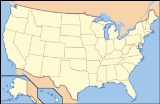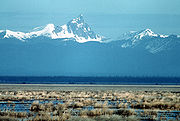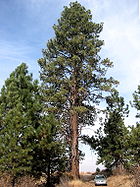
Klamath Basin National Wildlife Refuges Complex
Encyclopedia
The Klamath Basin National Wildlife Refuge Complex is a wildlife preserve operated by the United States Fish and Wildlife Service
located in the Klamath Basin
of southern Oregon
and northern California
near Klamath Falls, Oregon
. It consists of Bear Valley
,
Klamath Marsh
and Upper Klamath
National Wildlife Refuge (NWR) in southern Oregon
and Lower Klamath
, Tule Lake
, and Clear Lake
NWR in northern California
.
Historically, the Klamath Basin
was dominated by approximately 185,000 acres (749 km2) of shallow lakes and freshwater marshes. these extensive wetlands attracted peak fall concentrations of over 6 million waterfowl and supported abundant populations of other water birds including American White Pelican
, Double Crested Cormorant
, and several Heron
species.
In 1905, the U.S. Bureau of Reclamation initiated the Klamath Reclamation Project to convert the lakes and marshes of the Lower Klamath Lake
and Tule Lake
areas to agricultural lands. As these wetlands receded, the reclaimed lands were opened to agricultural development and settlement. Today, less than 25% of the historic wetlands remain.
To conserve much of the Basin's remaining wetland habitat, the six National Wildlife Refuges have been established. The U.S. Fish and Wildlife Service manages these Refuges to enhance wildlife and benefit the American people. Agricultural and water programs are coordinated under an agreement between the Fish and Wildlife Service and the Bureau of Reclamation.
Klamath Basin Refuges consist of a variety of habitats including freshwater marshes, open water, grassy meadows, coniferous forests, sagebrush and juniper grasslands, agricultural lands, and rocky cliffs and slopes. These habitats support diverse and abundant populations of resident and migratory wildlife with 433 species having been observed on or near the Refuges. In addition, each year the Refuges serve as a migratory stopover for about three-quarters of the Pacific Flyway waterfowl, with peak fall concentrations of over 1 million birds.


United States Fish and Wildlife Service
The United States Fish and Wildlife Service is a federal government agency within the United States Department of the Interior dedicated to the management of fish, wildlife, and natural habitats...
located in the Klamath Basin
Klamath Basin
The Klamath Basin is the region in the U.S. states of Oregon and California drained by the Klamath River. It contains most of Klamath County and parts of Lake and Jackson counties in Oregon, and parts of Del Norte, Humboldt, Modoc, Siskiyou, and Trinity counties in California. The drainage basin...
of southern Oregon
Oregon
Oregon is a state in the Pacific Northwest region of the United States. It is located on the Pacific coast, with Washington to the north, California to the south, Nevada on the southeast and Idaho to the east. The Columbia and Snake rivers delineate much of Oregon's northern and eastern...
and northern California
California
California is a state located on the West Coast of the United States. It is by far the most populous U.S. state, and the third-largest by land area...
near Klamath Falls, Oregon
Klamath Falls, Oregon
Klamath Falls is a city in Klamath County, Oregon, United States. Originally called Linkville when George Nurse founded the town in 1867, after the Link River on whose falls this city sat, although no falls currently exist; the name was changed to Klamath Falls in 1892...
. It consists of Bear Valley
Bear Valley National Wildlife Refuge
The Bear Valley National Wildlife Refuge is a wildlife refuge located in the southwestern part of Klamath County, Oregon, near the California border. It was established in 1978 to protect the nesting areas of Bald Eagles...
,
Klamath Marsh
Klamath Marsh National Wildlife Refuge
Klamath Marsh National Wildlife Refuge was established in 1958 when approximately were purchased from the Klamath tribe with Federal Duck Stamp Funds. In 1990 and 1998, additional acquisitions boosted Refuge acreage to 40,646...
and Upper Klamath
Upper Klamath National Wildlife Refuge
The Upper Klamath National Wildlife Refuge is a wildlife refuge located in southwestern Klamath County on the shores of Upper Klamath Lake in Oregon. It was established in 1928 and contains some of freshwater marshes. It is accessible only by boat...
National Wildlife Refuge (NWR) in southern Oregon
Oregon
Oregon is a state in the Pacific Northwest region of the United States. It is located on the Pacific coast, with Washington to the north, California to the south, Nevada on the southeast and Idaho to the east. The Columbia and Snake rivers delineate much of Oregon's northern and eastern...
and Lower Klamath
Lower Klamath National Wildlife Refuge
The Lower Klamath National Wildlife Refuge is a wildlife preserve operated by the United States Fish and Wildlife Service located in the Klamath Basin along a portion of the northern California and southern Oregon border near Klamath Falls, Oregon...
, Tule Lake
Tule Lake National Wildlife Refuge
The Tule Lake National Wildlife Refuge is a wildlife preserve operated by the United States Fish and Wildlife Service located in the Klamath Basin in northern California near the Oregon border south of Klamath Falls, Oregon....
, and Clear Lake
Clear Lake National Wildlife Refuge
Clear Lake National Wildlife Refuge in northeastern California consists of approximately of open water surrounded by over of upland bunchgrass, low sagebrush, and juniper habitat...
NWR in northern California
California
California is a state located on the West Coast of the United States. It is by far the most populous U.S. state, and the third-largest by land area...
.
| - |  |
- Lower Klamath NWR, established in 1908, was the first waterfowl refuge in the United States. Consisting of 46,900 acre (190 km2), it includes shallow freshwater marshes, open water, grassy uplands, and croplands that are intensively managed to provide feeding, resting, nesting, and brood rearing habitat for waterfowl and other water birds.
- Clear Lake NWR, established in 1911, has an area of 46,460 acres (188 km2). About 20,000 acres (81 km2) is open water. The balance is the surrounding upland habitat of bunchgrass, low sagebrush, and juniper.
- Upper Klamath NWR, established in 1928, is composed of 15,000 acres (61 km2) of mostly freshwater marshMarshIn geography, a marsh, or morass, is a type of wetland that is subject to frequent or continuous flood. Typically the water is shallow and features grasses, rushes, reeds, typhas, sedges, other herbaceous plants, and moss....
and open water. - Tule Lake NWR, established in 1928, encompasses 39,116 acres (158 km2) of mostly open water and croplands.
- Klamath Marsh NWR, established in 1958, consists of 40,646 acres (164 km2) of freshwater marsh and adjacent meadows.
- Bear Valley NWR, established in 1978, protects a vital night roost site for wintering bald eagles. It consists of 4,200 acres (17 km2) of largely old growth Ponderosa PinePonderosa PinePinus ponderosa, commonly known as the Ponderosa Pine, Bull Pine, Blackjack Pine, or Western Yellow Pine, is a widespread and variable pine native to western North America. It was first described by David Douglas in 1826, from eastern Washington near present-day Spokane...
, Incense-cedarCalocedrusCalocedrus is a genus of three species of coniferous trees in the cypress family Cupressaceae.The generic name means "beautiful cedar".-Description:...
, White FirWhite FirWhite Fir is a fir native to the mountains of western North America, occurring at altitudes of 900-3,400 m. It is a medium to large evergreen coniferous tree growing to 25–60 m tall and with a trunk diameter of up to 2 m . It is popular as an ornamental landscaping tree and as a Christmas Tree...
and Douglas-firDouglas-firDouglas-fir is one of the English common names for evergreen coniferous trees of the genus Pseudotsuga in the family Pinaceae. Other common names include Douglas tree, and Oregon pine. There are five species, two in western North America, one in Mexico, and two in eastern Asia...
forest.
Historically, the Klamath Basin
Klamath Basin
The Klamath Basin is the region in the U.S. states of Oregon and California drained by the Klamath River. It contains most of Klamath County and parts of Lake and Jackson counties in Oregon, and parts of Del Norte, Humboldt, Modoc, Siskiyou, and Trinity counties in California. The drainage basin...
was dominated by approximately 185,000 acres (749 km2) of shallow lakes and freshwater marshes. these extensive wetlands attracted peak fall concentrations of over 6 million waterfowl and supported abundant populations of other water birds including American White Pelican
American White Pelican
The American White Pelican is a large aquatic bird from the order Pelecaniformes. It breeds in interior North America, moving south and to the coasts, as far as Central America, in winter....
, Double Crested Cormorant
Cormorant
The bird family Phalacrocoracidae is represented by some 40 species of cormorants and shags. Several different classifications of the family have been proposed recently, and the number of genera is disputed.- Names :...
, and several Heron
Heron
The herons are long-legged freshwater and coastal birds in the family Ardeidae. There are 64 recognised species in this family. Some are called "egrets" or "bitterns" instead of "heron"....
species.
In 1905, the U.S. Bureau of Reclamation initiated the Klamath Reclamation Project to convert the lakes and marshes of the Lower Klamath Lake
Lower Klamath Lake
Lower Klamath Lake is a lake in Siskiyou County, California, that currently serves to hold overflow water for irrigation. At one time it was connected to Upper Klamath Lake....
and Tule Lake
Tule Lake
Tule Lake is an intermittent lake covering an area of , long and across, in northeastern Siskiyou County and northwestern Modoc County in California, along the border with Oregon.-Geography:Tule Lake is fed by the Lost River...
areas to agricultural lands. As these wetlands receded, the reclaimed lands were opened to agricultural development and settlement. Today, less than 25% of the historic wetlands remain.
To conserve much of the Basin's remaining wetland habitat, the six National Wildlife Refuges have been established. The U.S. Fish and Wildlife Service manages these Refuges to enhance wildlife and benefit the American people. Agricultural and water programs are coordinated under an agreement between the Fish and Wildlife Service and the Bureau of Reclamation.
Klamath Basin Refuges consist of a variety of habitats including freshwater marshes, open water, grassy meadows, coniferous forests, sagebrush and juniper grasslands, agricultural lands, and rocky cliffs and slopes. These habitats support diverse and abundant populations of resident and migratory wildlife with 433 species having been observed on or near the Refuges. In addition, each year the Refuges serve as a migratory stopover for about three-quarters of the Pacific Flyway waterfowl, with peak fall concentrations of over 1 million birds.
Units include

- Bear Valley National Wildlife RefugeBear Valley National Wildlife RefugeThe Bear Valley National Wildlife Refuge is a wildlife refuge located in the southwestern part of Klamath County, Oregon, near the California border. It was established in 1978 to protect the nesting areas of Bald Eagles...
- Clear Lake National Wildlife RefugeClear Lake National Wildlife RefugeClear Lake National Wildlife Refuge in northeastern California consists of approximately of open water surrounded by over of upland bunchgrass, low sagebrush, and juniper habitat...
- Klamath Marsh National Wildlife RefugeKlamath Marsh National Wildlife RefugeKlamath Marsh National Wildlife Refuge was established in 1958 when approximately were purchased from the Klamath tribe with Federal Duck Stamp Funds. In 1990 and 1998, additional acquisitions boosted Refuge acreage to 40,646...
- Lower Klamath National Wildlife RefugeLower Klamath National Wildlife RefugeThe Lower Klamath National Wildlife Refuge is a wildlife preserve operated by the United States Fish and Wildlife Service located in the Klamath Basin along a portion of the northern California and southern Oregon border near Klamath Falls, Oregon...
- Tule Lake National Wildlife RefugeTule Lake National Wildlife RefugeThe Tule Lake National Wildlife Refuge is a wildlife preserve operated by the United States Fish and Wildlife Service located in the Klamath Basin in northern California near the Oregon border south of Klamath Falls, Oregon....
- Upper Klamath National Wildlife RefugeUpper Klamath National Wildlife RefugeThe Upper Klamath National Wildlife Refuge is a wildlife refuge located in southwestern Klamath County on the shores of Upper Klamath Lake in Oregon. It was established in 1928 and contains some of freshwater marshes. It is accessible only by boat...
External links


